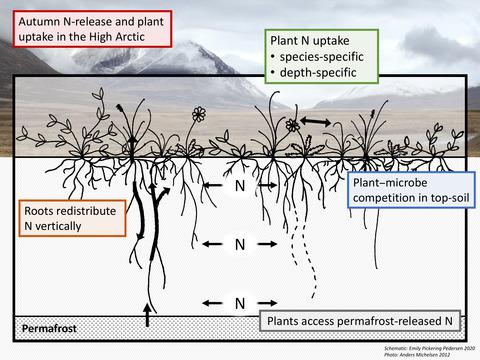当前位置:
X-MOL 学术
›
Glob. Change Biol.
›
论文详情
Our official English website, www.x-mol.net, welcomes your
feedback! (Note: you will need to create a separate account there.)
Foraging deeply: Depth-specific plant nitrogen uptake in response to climate-induced N-release and permafrost thaw in the High Arctic.
Global Change Biology ( IF 10.8 ) Pub Date : 2020-08-10 , DOI: 10.1111/gcb.15306 Emily P Pedersen 1, 2 , Bo Elberling 2 , Anders Michelsen 1, 2
Global Change Biology ( IF 10.8 ) Pub Date : 2020-08-10 , DOI: 10.1111/gcb.15306 Emily P Pedersen 1, 2 , Bo Elberling 2 , Anders Michelsen 1, 2
Affiliation

|
Warming in the Arctic accelerates top‐soil decomposition and deep‐soil permafrost thaw. This may lead to an increase in plant‐available nutrients throughout the active layer soil and near the permafrost thaw front. For nitrogen (N) limited high arctic plants, increased N availability may enhance growth and alter community composition, importantly affecting the ecosystem carbon balance. However, the extent to which plants can take advantage of this newly available N may be constrained by the following three factors: vertical distribution of N within the soil profile, timing of N‐release, and competition with other plants and microorganisms. Therefore, we investigated species‐ and depth‐specific plant N uptake in a high arctic tundra, northeastern Greenland. Using stable isotopic labelling (15N‐NH4+), we simulated autumn N‐release at three depths within the active layer: top (10 cm), mid (45 cm) and deep‐soil near the permafrost thaw front (90 cm). We measured plant species‐specific N uptake immediately after N‐release (autumn) and after 1 year, and assessed depth‐specific microbial N uptake and resource partitioning between above‐ and below‐ground plant parts, microorganisms and soil. We found that high arctic plants actively foraged for N past the peak growing season, notably the graminoid Kobresia myosuroides. While most plant species (Carex rupestris, Dryas octopetala, K. myosuroides) preferred top‐soil N, the shrub Salix arctica also effectively acquired N from deeper soil layers. All plants were able to obtain N from the permafrost thaw front, both in autumn and during the following growing season, demonstrating the importance of permafrost‐released N as a new N source for arctic plants. Finally, microbial N uptake markedly declined with depth, hence, plant access to deep‐soil N pools is a competitive strength. In conclusion, plant species‐specific competitive advantages with respect to both time‐ and depth‐specific N‐release may dictate short‐ and long‐term plant community changes in the Arctic and consequently, larger‐scale climate feedbacks.
中文翻译:

深入觅食:高海拔地区因气候引起的氮释放和多年冻土融化而对特定深度的植物氮的吸收。
北极变暖会加速表层土壤分解和深层多年冻土融化。这可能导致整个活动层土壤和多年冻土融化前沿附近的植物有效养分增加。对于氮素有限的高北极植物,增加的氮素利用率可能会促进生长并改变群落组成,从而严重影响生态系统的碳平衡。但是,植物利用这种新获得的氮的程度可能受到以下三个因素的限制:氮在土壤剖面内的垂直分布,氮释放的时机以及与其他植物和微生物的竞争。因此,我们研究了格陵兰岛东北部一个高寒带苔原上物种和深度特定的植物对氮的吸收。使用稳定的同位素标记(15 N‐NH 4+),我们模拟了活动层内三个深度处的秋季氮释放:顶部(10 cm),中部(45 cm)和靠近永久冻土融化锋面(90 cm)的深层土壤。我们测量了氮释放后(秋季)和一年后植物物种特异性氮的吸收,并评估了深度特异性微生物氮的吸收以及地上和地下植物部分,微生物和土壤之间的资源分配。我们发现,在高峰生长期之后,高北极植物活跃地觅食了氮,尤其是粒状小嵩草(Kobresia myosuroides)。虽然大多数植物物种(草地棉(Carex rupestris),八叶树(Dryas octopetala),鼠尾草(K. myosuroides))偏爱表层土壤氮,但灌木柳也有效地从更深的土壤层中获取了氮。在秋季和随后的生长季节,所有植物都能从多年冻土融化的前沿获得氮,这表明多年冻土释放的氮作为北极植物新的氮源的重要性。最后,微生物对氮的吸收随着深度的增加而显着下降,因此,进入深土壤氮库的植物具有竞争优势。总而言之,在时间和深度上特定的氮释放方面,特定于植物物种的竞争优势可能决定了北极地区植物群落的短期和长期变化,从而决定了更大范围的气候反馈。
更新日期:2020-10-19
中文翻译:

深入觅食:高海拔地区因气候引起的氮释放和多年冻土融化而对特定深度的植物氮的吸收。
北极变暖会加速表层土壤分解和深层多年冻土融化。这可能导致整个活动层土壤和多年冻土融化前沿附近的植物有效养分增加。对于氮素有限的高北极植物,增加的氮素利用率可能会促进生长并改变群落组成,从而严重影响生态系统的碳平衡。但是,植物利用这种新获得的氮的程度可能受到以下三个因素的限制:氮在土壤剖面内的垂直分布,氮释放的时机以及与其他植物和微生物的竞争。因此,我们研究了格陵兰岛东北部一个高寒带苔原上物种和深度特定的植物对氮的吸收。使用稳定的同位素标记(15 N‐NH 4+),我们模拟了活动层内三个深度处的秋季氮释放:顶部(10 cm),中部(45 cm)和靠近永久冻土融化锋面(90 cm)的深层土壤。我们测量了氮释放后(秋季)和一年后植物物种特异性氮的吸收,并评估了深度特异性微生物氮的吸收以及地上和地下植物部分,微生物和土壤之间的资源分配。我们发现,在高峰生长期之后,高北极植物活跃地觅食了氮,尤其是粒状小嵩草(Kobresia myosuroides)。虽然大多数植物物种(草地棉(Carex rupestris),八叶树(Dryas octopetala),鼠尾草(K. myosuroides))偏爱表层土壤氮,但灌木柳也有效地从更深的土壤层中获取了氮。在秋季和随后的生长季节,所有植物都能从多年冻土融化的前沿获得氮,这表明多年冻土释放的氮作为北极植物新的氮源的重要性。最后,微生物对氮的吸收随着深度的增加而显着下降,因此,进入深土壤氮库的植物具有竞争优势。总而言之,在时间和深度上特定的氮释放方面,特定于植物物种的竞争优势可能决定了北极地区植物群落的短期和长期变化,从而决定了更大范围的气候反馈。











































 京公网安备 11010802027423号
京公网安备 11010802027423号